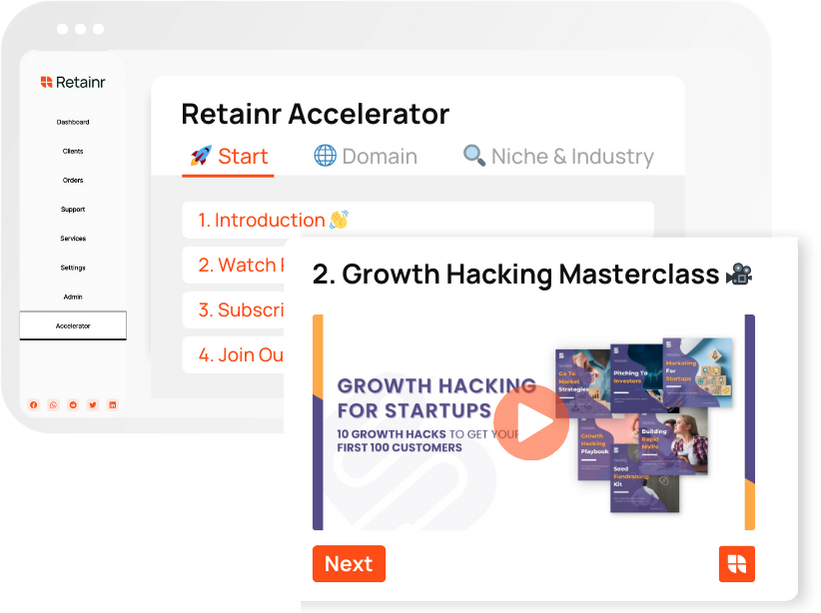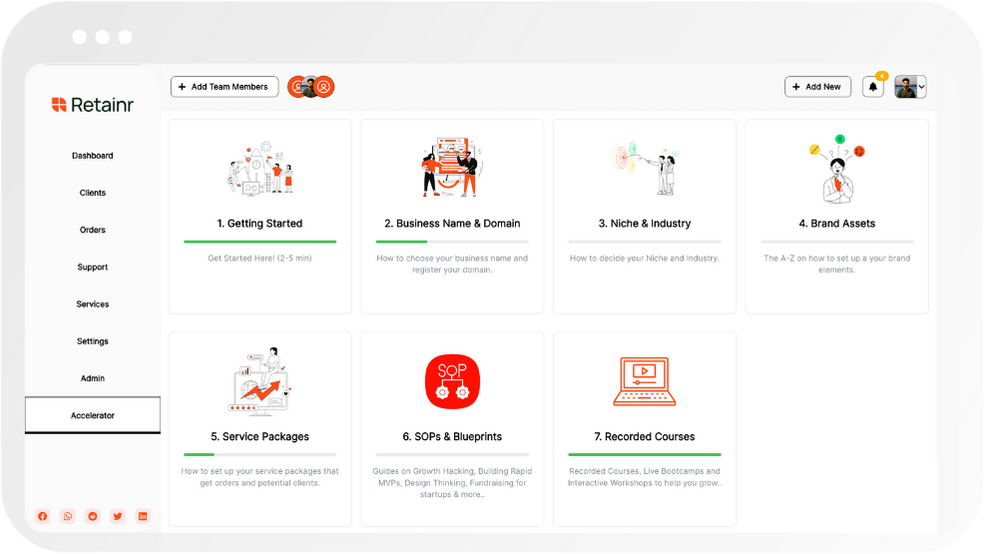
7 Successful Remote Working Strategies for Long Term
Build with Retainr
Sell your products and services, manage clients, orders, payments, automate your client onboarding and management with your own branded web application.
Get Started1. What are the top seven successful remote working strategies for long term?
The Top Seven Effective Remote Working Strategies
Working remotely, while providing flexibility, can also present certain challenges. Therefore, it is crucial to establish effective strategies to ensure long-term success. Below are the top seven strategies for effective remote working:
- Establishing a Dedicated Workspace: This helps in creating a work-like environment, minimizing distractions and promoting productivity.
- Regular Breaks: It's essential to schedule regular breaks to stretch, rest your eyes, and recharge. This aids in avoiding burnout and maintaining focus.
- Creating a Daily Routine: By building a routine, you give structure to your day and develop a work-life balance.
- Time Management: Prioritize tasks and use tools like calendars and to-do lists to manage time effectively.
- Communication: Maintain regular communication with your team using various tools like emails, video calls, and instant messaging apps.
- Set Boundaries: Let family or housemates know about your working hours to minimize interruptions.
- Invest in Reliable Technology: Make sure to have a stable internet connection and all necessary hardware and software to avoid potential disruptions.
Detailed Explanation of The Top Seven Strategies
In the table below, each strategy is elaborated to provide a deeper insight:
| Strategy | Description |
|---|---|
| Establishing a Dedicated Workspace | This could be an entire room or a corner of your home. Ensure this space is quiet, comfortable, and free from distractions. |
| Regular Breaks | Schedule short breaks after every hour or two. This helps in resetting your focus and preventing fatigue. |
| Creating a Daily Routine | Create and follow a daily routine. Start and end your day at the same time as you would in an office setting to maintain regularity. |
| Time Management | Prioritize tasks based on their urgency and importance. Use task management tools to track your progress. |
| Communication | Stay connected with your team to maintain a sense of camaraderie. Regular communication also ensures everyone is on the same page. |
| Set Boundaries | Establish clear boundaries with family or housemates during your working hours. This ensures you can work undisturbed. |
| Invest in Reliable Technology | Ensure that you have a stable internet connection as well as working hardware and software. This could include a reliable laptop, a comfortable keyboard and mouse, and necessary software specific to your job. |
2. How can these strategies improve productivity in remote working situations?
Improving Productivity through Effective Remote Working Strategies
Remote working strategies that are meticulously planned and executed can significantly enhance productivity in several ways. First, they reduce commute time for employees, providing them with extra hours to focus on their tasks. Such strategies also offer flexible work hours, which accommodate different peaks in energy levels and work rhythms. This flexibility promotes a healthier work-life balance, reducing stress and burnout, leading to increased productivity.
- Reduced commute time: Eliminates the hours spent traveling to and from the workplace.
- Flexible work hours: Allows the employee to schedule tasks at times when their focus and energy levels are at their highest.
- Work-life balance: Prevents burnout by allowing the employee to allocate time for personal interests and relaxation.
The extent of productivity improvement due to these strategies can be measured against key performance indicators (KPIs). For instance, employers can monitor the rate of task completion, quality of work produced, and the effectiveness of communication and collaboration amongst remote workers. This can provide accurate data on the impact of these strategies on workforce productivity.
| KPIs | Description |
|---|---|
| Task completion rate | Measures how quickly and efficiently tasks are completed |
| Quality of work | Assesses the standards of work produced by the employees |
| Communication and collaboration efficiency | Evaluates how well remote employees communicate and work together to achieve desired results |
3. Are these strategies applicable to all types of businesses or are they industry-specific?
Applicability of Remote Working Strategies Across Various Industries
These remote working strategies are generally applicable to a broad spectrum of businesses, regardless of their type or industry. However, the level of applicability can vary considerably, depending on the nature of the business operations and extent of customer interaction. Here are instances where these strategies may find the most applicability:
- Business operations that are predominantly digital, such as IT services, digital marketing, and e-commerce.
- Roles that require little to no physical interactions, such as virtual assistants, content writers, and graphic designers.
- Business sectors that offer consultation services, such as law firms, accounting agencies, and management consultants.
Adapting Remote Working Strategies in Different Sectors
Adaptation of these strategies may need tailoring based on the sector. For instance, in the manufacturing industry where physical presence is essential, these strategies may need to focus more on hybrid working models. Here are a few examples of how these strategies can be adapted:
| Industry | Strategic Adaptation |
|---|---|
| Manufacturing Industry | Adopt a hybrid work model, combine remote administrative tasks with on-site manufacturing work. |
| Healthcare Sector | Leverage telemedicine for remote healthcare services, while maintaining physical services for critical conditions. |
| Education Sector | Implement an online classroom system, interspersed with in-person interactive sessions. |
Remote Work Strategies in Physical-Reliant Businesses
Although businesses that rely heavily on physical interaction may find less applicability, there are still remote-centric strategies that can be employed. For example, these businesses can incorporate administrative tasks, customer service, and marketing functions remotely. They could also leverage digital media and tools for customer engagement, digital marketing, and product demonstration. Consequently, it is safe to conclude that remote working strategies are not industry-specific and can be adapted to fit the various needs and conditions of any business type.
4. How can a company efficiently implement these remote working strategies?
Planning and Investment
For effective implementation of remote working strategies, companies should initially invest time and resources in planning. The plan should include procuring necessary hardware and software, clearly defining the expectations from employees, and establishing an effective mode of communication.
- Hardware and Software: Companies should invest in reliable tools and equipment that remote workers will need, such as laptops and relevant software. Proper initial investment will benefit the company in the long run.
- Setting Expectations: Companies should outline clear workflow processes and expectations from their remote employees. They should provide guidelines on work hours, regular check-ins, and project deadlines.
- Communication: Companies should choose an effective medium of communication. Whether it's Slack, Microsoft Teams, or another platform, a common platform should be selected for seamless communication.
Training and Support
Training employees appropriately for remote work is crucial. This will not only prepare them for the change, but also help them to perform their tasks more effectively. Here are some important thing to consider:
| Training Segments | Description |
|---|---|
| Technology Training | Training on how to use various apps, tools, and platforms relevant to the work. |
| Policy Orientations | Conducting sessions to make workers aware of the company's remote working policies. |
| Wellness Programs | Encouraging remote workers to partake in wellness programs to ensure work-life balance. |
Maintaining Engagement
One of the major challenges with remote work is to maintain high levels of employee engagement. Remote workers can often feel isolated from the organization. A few methods to ensure high engagement among remote workers include:
- Regular Feedback: By providing regular feedback and discussing progress, employers can make remote employees feel valued.
- Employee Recognition: Rewarding employees for their achievements and recognizing their hard work can boost morale and improve performance.
- Interactive Sessions: Hosting interactive online meetings or virtual team-building activities can help employees feel more connected to the team.
5. Do these strategies help in maintaining work-life balance for employees?
Importance of Strategies for Maintaining Work-Life Balance
Adopting effective remote working strategies is paramount in maintaining work-life balance for employees. This is because these strategies provide a plan that enables workers to allocate their time efficiently, reducing the chances of work encroaching into personal life. For instance:
- By implementing a flexible schedule, employees can handle professional tasks at their own pace and have personal time for their social life.
- With the help of project management tools, workers can keep track of their workflow which reduces pressure, ensuring a healthy balance between work and personal life.
- Having regular breaks during work hours can prevent burnout, making employees more productive and happy, which in turn leads to a positive work-life balance.
The Impact on Mental Health
Striking a balance between work and personal life is not just about organizing time, it also substantially contributes to mental well-being. Below we showcase the impact with help of a table:
| Strategy | Mental Health Benefit |
|---|---|
| Flexible Schedule | Reduces stress and increases satisfaction. |
| Project Management Tools | Maintains focus and organization, thereby reducing anxiety. |
| Regular Breaks | Helps to relax, replenishing energy levels and mental resilience. |
Work-Life Balance as a Sustainability Strategy
Maintaining work-life balance is not a luxury, but a sustainability strategy for both companies and their employees. For instance:
- Companies that encourage work-life balance have higher employee retention as they foster a healthy work environment.
- Such companies also attract top talent who seek a company culture that supports their lifestyle.
- For employees, striking a good work-life balance means reducing the risk of burnout, improving mental well-being, and increasing overall job satisfaction.
6. What role do these strategies play in employee engagement and motivation?
The Role of Remote Working Strategies in Employee Engagement and Motivation
Remote working strategies significantly influence employee engagement and motivation. By creating a conducive working environment, providing adequate resources, and facilitating effective communication, employees can remain connected to their teams and enthusiastic about their work.
- Building a conducive working environment: Remote work policies can help establish a balanced and comfortable working environment, promoting employee efficiency and satisfaction. Furthermore, the flexibility offered by remote working can lead to improved morale and reduced stress, increasing employee engagement.
- Providing adequate resources: By ensuring employees have the necessary resources for their work, organizations can avoid productivity pitfalls. Essentials like reliable internet, access to work email or workspace, and necessary software can make remote work manageable and efficient, thereby keeping employees motivated.
- Facilitating effective communication: Regular check-ins, meetings, and feedback sessions can help remote employees feel connected and valued, which is critical for maintaining their motivation and engagement levels.
| Strategy | Impact on Engagement | Impact on Motivation |
|---|---|---|
| Conducive Working Environment | High | High |
| Providing Adequate Resources | Medium | High |
| Effective Communication | High | High |
In conclusion, implementing effective remote working strategies can play a vital role in fostering employee engagement and motivation. Allowing for a balanced work-life, providing necessary resources, and maintaining open communication not only ensures productivity but also motivates employees to stay committed to their roles.
7. How can these strategies help in managing and organizing a remote team?
Effective Implementation of Remote Working Strategies
The successful implementation of remote working strategies can significantly help in managing and organizing a remote team. It can create a comfortable work environment allowing team members to deliver their best performance. The roles and responsibilities of every team member become clear, and everyone knows what is expected from them.
Role of Strategic Communication
Strategic communication can play a massive role in successfully managing a remote team. The following methods can be beneficial:
- Consistent updates help in keeping everyone on the same page and reducing misunderstandings.
- It encourages open communication ensuring all queries and issues are quickly resolved.
- Platforms for efficient communication should be chosen thoughtfully to avoid any technical difficulties.
Importance of Work Planning and Scheduling
Work planning and scheduling are vital components of remote working strategies. They streamline the workflow and bring organization to the team. The following table showcases its importance.
| Benefits | Explanation |
|---|---|
| Maximizes productivity | By scheduling tasks, the team can efficiently work without confusion about priorities and deadlines. |
| Reduces stress | Knowing what is expected and when helps reduce anxiety and stress amongst team members. |
| Cultivates team synergy | Efficient scheduling ensures all team members are working cohesively towards the same goal at the right time. |
8. What are the tools or software systems that can help implement these remote working strategies?
Essential Tools and Software for Remote Working
Several tools and software systems are key to successful and sustainable remote work strategies. There are a variety of categories these tools fall into. The categories include project management software, communication tools, virtual meeting platforms, file sharing systems, and time management tools. The choice of software greatly depends on the specific needs and operational demands of a business.
- Project Management Software: Examples include Monday.com, Trello, and Asana. These help coordinate tasks and projects, track progress, and improve productivity.
- Communication Tools: Slack, Microsoft Teams, or Google Chat offer seamless text, voice, and video communication in real-time.
- Virtual Meeting Platforms: Zoom, Microsoft Teams, or Google Meet are platform of choice for virtual meetings and webinars.
- File Sharing Systems: Google Drive, Microsoft OneDrive, and Dropbox are used to store, share, and collaborate on files.
- Time Management Tools: Rescue Time, Time Doctor, or Toggl help track time, increase focus, and enhance productivity.
Tool Comparison
Each training tool offers unique benefits and features. Here we compared them based on multiple factors including ease of use, cost, and functionality.
| Tool | Ease of Use | Cost | Functionality |
|---|---|---|---|
| Monday.com | High | Medium | High |
| Slack | High | Low | High |
| Zoom | High | Low to Medium | High |
| Google Drive | High | Low | Medium |
| Rescue Time | Medium | Low | Medium |
9. Can these strategies affect the overall growth and profits of the business in the long term?
Impact on Business Growth and Profits
Successful remote working strategies can significantly impact the overall growth and profits of a business in the long-term. It's necessary to think about it from different perspectives such as cost savings, productivity improvement, larger talent pool, and enhanced employee satisfaction.
Cost Savings
- Reduced office space: With the remote working model, businesses can save a tremendous amount on fixed costs such as rent, utilities, and office supplies.
- Decreased absenteeism: Remote employees are generally able to maintain better physical and mental health, minimizing the number of sick leaves. This can directly enhance productivity and profitability.
- Lower overtime costs: Allowing remote work gives employees the flexibility to manage their time, reducing the need for overtime that may otherwise inflate employment costs.
Productivity Improvement
| Traditional Work Model | Remote Work Model |
|---|---|
| Employees commute, leading to exhaustion and stress. | No commute time helps employees start their day energetically, leading to better performance. |
| Possible distractions from office environment. | Remote working can reduce distractions, thus increasing productivity. |
| Organizational culture may foster bureaucracy, slowing down the decision-making process. | Remote working can help build a results-oriented culture where the focus is on the outcome rather than the process. |
The long-term sustainability and success of a company are closely linked to its working model. By adopting appropriate remote working strategies, businesses can unlock numerous benefits ranging from cost savings to productivity enhancement. Besides these tangible benefits, they can also achieve intangible advantages such as improved reputation and stronger resilience amid crises, paving the way for long-term growth and profitability.
10. How can these strategies ensure effective communication within the remote team?
Boosting Communication via Remote Working Strategies
One of the crucial elements for a successful remote team is open and effective communication. Application of successful remote working strategies could enhance the communication flow within the team. Commonly applied techniques include planned regular meetings, use of various collaboration tools, and instilling a culture of openness.
- Regular Meetings: Weekly or bi-weekly team meetings could be scheduled to update team members about project progress or any other important issue. These meetings enable members to clarify queries or report bottlenecks in their tasks. This technique ensures continuity of work flow and minimizes miscommunications.
- Collaboration Tools: The use of advanced collaboration tools like Slack, MS Teams, or Zoom simplifies remote communications. These platforms function beyond plain email communication offering features like instant messaging, video conferencing, and task management. These make communication among remote team members more effective.
- Openness Culture: Promoting an open culture that encourages team members to express their thoughts, ideas, and concerns freely also aids in effective communication. This culture alleviates hesitation and enables team members to communicate freely whenever required.
Examples of Effective Communication Strategies
Effectiveness of the above strategies can vary based upon team size, expertise level, work nature, and other factors. Hence, you may need to fine-tune your communication strategies. Below is a simple comparison of two different models:
| Strategy | Small Team | Large Team |
|---|---|---|
| Regular Meetings | Weekly Meetings | Weekly/bi-weekly depending on team size |
| Collaboration Tools | Lite versions with fewer integrations | Full version with all necessary integrations and features |
| Openness Culture | Informal round-the-table task updates | Well-structured project updates with pre-set agenda |
The Impact of Effective Communication
Having effective communication strategies ensures smooth completion of projects, encourages strong team bonding and increases overall team productivity. Remember, communication acts as the bridge between team members when working remotely and replaces the casual conversations that happen in office spaces. Thus, clear, transparent and regular interactions are the key to keeping a remote team aligned and engaged.
Conclusion
Mastering the Art of Remote Working
Working remotely offers a host of advantages, from flexibility in schedule to increased productivity. It's not without its challenges, however. But with the right strategies, you can enhance your remote working experience and enjoy long-term success. Here are seven key strategies that have been proved to promote successful remote working in the long haul.1. Create a Routine
Give structure to your day by developing a consistent routine. This helps to maintain focus and ensures key tasks are completed on schedule.2. Separate Work from Home
Dedicate a specific area in your home just for work. This separation minimises distractions and improves work-life balance.3. Regular Communication
Regular updates between team members is crucial. Tools like Zoom or Slack ensure everyone is on the same page, promoting better collaboration.4. Set Clear Expectations
Ensure team members know what is expected of them. They should understand their key roles, tasks to be completed, and deadlines.5. Prioritise Your Health
Remote work can sometimes become sedentary. Ensure you prioritize physical activity and breaks during your day for healthier work habits.6. Use Reliable Technology
Use reliable hardware and software that supports remote work. Rising startups like Retainr.io have introduced innovative solutions to smooth customer management and account servicing remotely.7. Harness the Power of Retainr.io
Retainr.io is a robust whitelabel software that enables you to sell, manage clients, orders and payments with your own branded app. With Retainr.io in your toolbox, remote working is made more streamlined and efficient. Retainr.io is the partner you need for long-term success in remote work. Click here to explore how Retainr.io can optimize your remote work performance.Boost Your Agency Growth
with Retainr Accelerator
Uncover secrets, strategies, and exclusive blueprints to take your agency's growth to the next level — from marketing insights to effective presentations and leveraging technology.

SOPs, Cheatsheets & Blueprints
Leverage 50+ SOPs (valued over $10K) offering practical guides, scripts, tools, hacks, templates, and cheat sheets to fast-track your startup's growth.
Connect with fellow entrepreneurs, share experiences, and get expert insights within our exclusive Facebook community.
.jpg)

Join a thriving community of growth hackers. Network, collaborate, and learn from like-minded entrepreneurs on a lifelong journey to success.

Gain expertise with recorded Courses, Live Bootcamps and interactive Workshops on topics like growth hacking, copywriting, no-code funnel building, performance marketing and more, taught by seasoned coaches & industry experts.

.jpg)

.jpeg)


